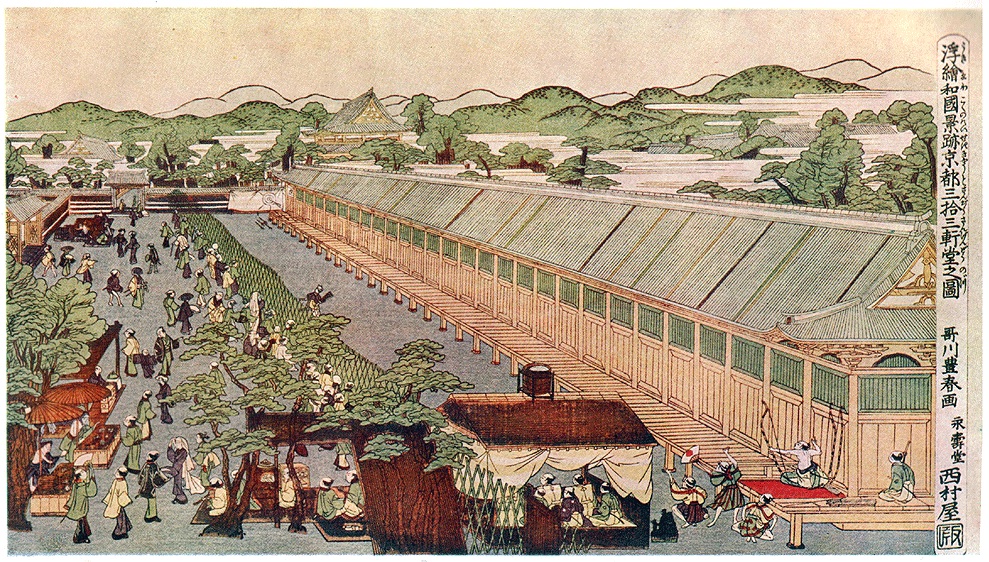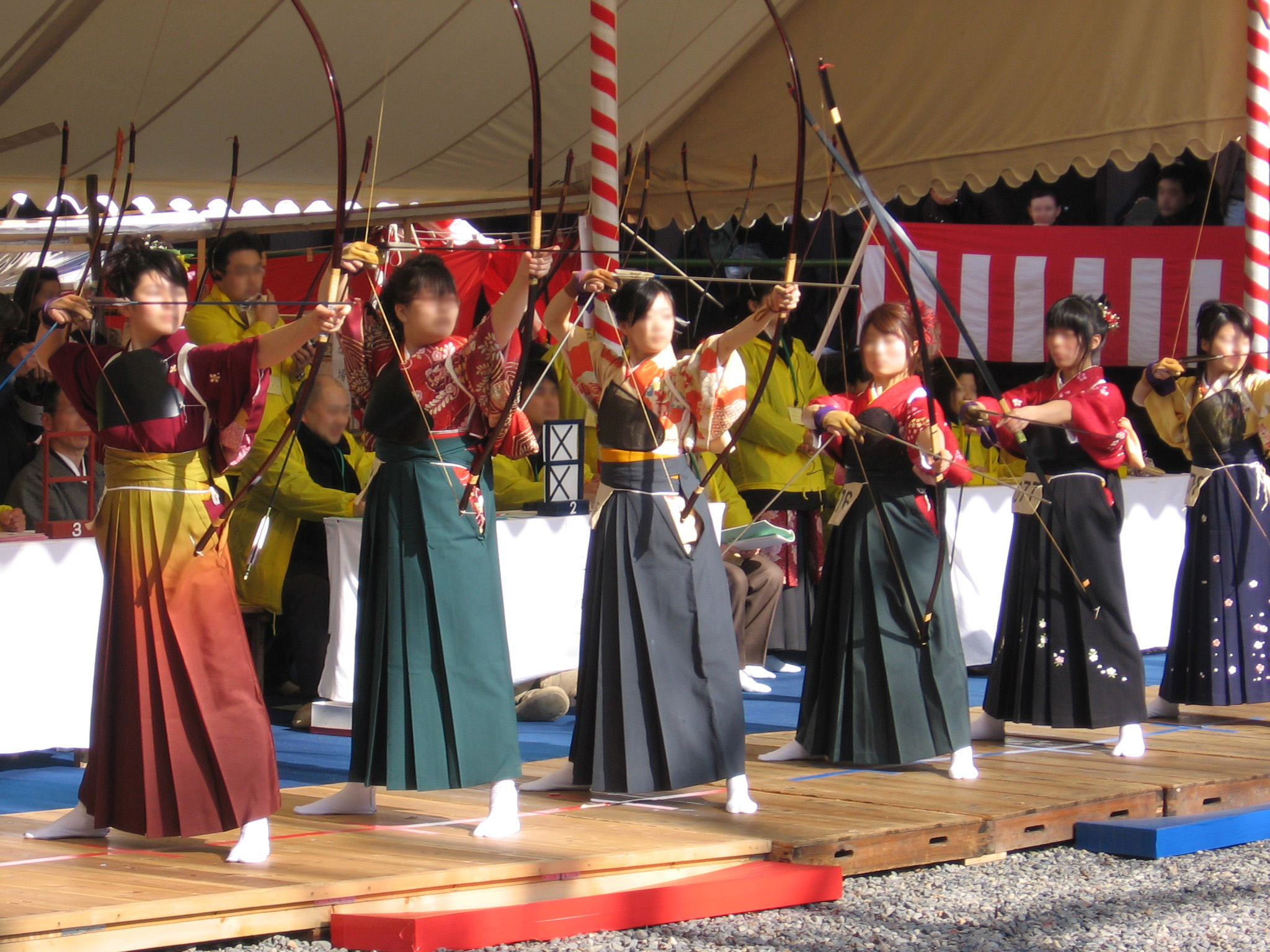Tōshiya on:
[Wikipedia]
[Google]
[Amazon]
 The or ''the arrows which hit the target'', was an
The or ''the arrows which hit the target'', was an
 There were four distinct events at the competition:
* The The archer who hit the target with the most out of 100 arrows was declared the winner.
* The The archer who hit the target with the most out of 1000 arrows was declared the winner. In 1827, an 11-year-old named Kokura Gishichi successfully hit the target 995 times shooting from half the distance of the hall.
* The Boys who had not yet celebrated their Genpuku, or coming-of-age ceremony, could compete in this event. Archers would shoot as many arrows as possible for a 12-hour period during the day. In 1774, the third year of the
There were four distinct events at the competition:
* The The archer who hit the target with the most out of 100 arrows was declared the winner.
* The The archer who hit the target with the most out of 1000 arrows was declared the winner. In 1827, an 11-year-old named Kokura Gishichi successfully hit the target 995 times shooting from half the distance of the hall.
* The Boys who had not yet celebrated their Genpuku, or coming-of-age ceremony, could compete in this event. Archers would shoot as many arrows as possible for a 12-hour period during the day. In 1774, the third year of the
 In 1861, after 255 years, the Tōshiya ceased being held, but a contest based on the Tōshiya called Ōmato Taikai, or ''Tournament of the Great Target'' still continues today, drawing roughly 2,000 participants from throughout Japan. Archers shoot arrows into targets approximately in diameter and 60 meters (198 feet) away at the opposite end of the veranda. It is held on the second Sunday of January in conjunction with the temple's most important mass, the Yanagi-no-Okaji, or ''Rite of the Willow'' ritual and Japan's
In 1861, after 255 years, the Tōshiya ceased being held, but a contest based on the Tōshiya called Ōmato Taikai, or ''Tournament of the Great Target'' still continues today, drawing roughly 2,000 participants from throughout Japan. Archers shoot arrows into targets approximately in diameter and 60 meters (198 feet) away at the opposite end of the veranda. It is held on the second Sunday of January in conjunction with the temple's most important mass, the Yanagi-no-Okaji, or ''Rite of the Willow'' ritual and Japan's
 The or ''the arrows which hit the target'', was an
The or ''the arrows which hit the target'', was an archery
Archery is the sport, practice, or skill of using a Bow and arrow, bow to shooting, shoot arrows.Paterson ''Encyclopaedia of Archery'' p. 17 The word comes from the Latin ''arcus'', meaning bow. Historically, archery has been used for hunting ...
exhibition contest held on the west veranda of Sanjūsangen-dō temple in Kyoto
Kyoto ( or ; Japanese language, Japanese: , ''Kyōto'' ), officially , is the capital city of Kyoto Prefecture in the Kansai region of Japan's largest and most populous island of Honshu. , the city had a population of 1.46 million, making it t ...
, Japan
Japan is an island country in East Asia. Located in the Pacific Ocean off the northeast coast of the Asia, Asian mainland, it is bordered on the west by the Sea of Japan and extends from the Sea of Okhotsk in the north to the East China Sea ...
.
History of the contest
The contest originated in the late 16th century dating back to 1606 when asamurai
The samurai () were members of the warrior class in Japan. They were originally provincial warriors who came from wealthy landowning families who could afford to train their men to be mounted archers. In the 8th century AD, the imperial court d ...
named Asaoka Heibei is said to have shot 51 arrows in rapid succession down the length of the veranda. In the beginning, archers shot arrows from the southern end of the veranda to the northern end where a curtain
A curtain is a piece of cloth or other material intended to block or obscure light, air drafts, or (in the case of a shower curtain) water.
Curtains are often hung on the inside of a building's windows to block the passage of light. For instan ...
-like ornament was erected as a target
Target may refer to:
Warfare and shooting
* Shooting target, used in marksmanship training and various shooting sports
** Bullseye (target), the goal one for which one aims in many of these sports
** Aiming point, in field artille ...
. The contest gained popularity during the Edo period
The , also known as the , is the period between 1600 or 1603 and 1868 in the history of Japan, when the country was under the rule of the Tokugawa shogunate and some 300 regional ''daimyo'', or feudal lords. Emerging from the chaos of the Sengok ...
and by the late 17th century competitions between participants from the Owari and Kishū provinces were drawing big crowds. The Tōshiya would later be used as a motif in stories and film.
An'ei
was a after '' Meiwa'' and before ''Tenmei.'' This period spanned the years November 1772 through March 1781. The reigning emperors were and .
Change of era
* 1772 : The era name was changed to ''An'ei'' (meaning "peaceful eternity") to mark ...
era, Masaaki Noro, a 13-year-old from Kishū, shot 11,715 arrows with almost all of them hitting the target.
* The This event is said to date from the Keichō
was a after '' Bunroku'' and before '' Genna''. This period spanned from October 1596 to July 1615. The reigning emperors were and .
Change of era
* 1596 : The era name was changed to ''Keichō'' to mark the passing of various natural disaste ...
era. Archers would shoot as many arrows as possible for a 24-hour period, loosing an average of 10,000 arrows. On April 26, 1686, Wasa Daihachiro from Kishū successfully hit 8,133 out of 13,053 arrows averaging 544 arrows an hour, or 9 arrows a minute, and became the record holder.
Champions were honored by having a certificate hung in the temple showing their name, age, the number of arrows shot and the date of the competition.
The contest today
Coming of Age Day
is a public holiday in Japan held annually on the second Monday of January under the Happy Monday System. It is held in order to congratulate and encourage all those who have already reached the age of maturity between April 2 of the previou ...
.
References
{{DEFAULTSORT:Toshiya 1606 establishments in Japan 1800s disestablishments History of archery Edo period Japanese games Japanese archery Sports competitions in Japan Tourist attractions in Kyoto Prefecture